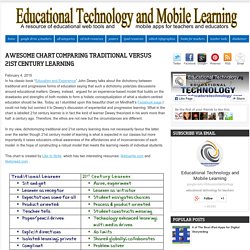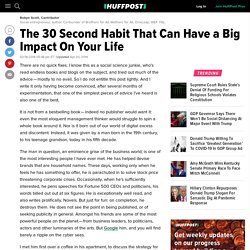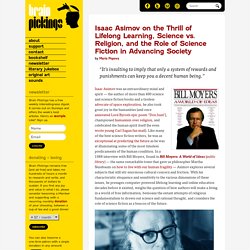

Awesome Chart Comparing Traditional Versus 21st Century Learning. February 4, 2015 In his classic book “Education and Experience” John Dewey talks about the dichotomy between traditional and progressive forms of education saying that such a dichotomy polarizes discussions around educational matters.

Dewey, instead, argued for an experience-based model that builds on the drawbacks and strengths of both models to form a holistic conceptualization of what a student-centred education should be like. Today, as I stumbled upon this beautiful chart on Mindhsift’s Facebook page I could not help but connect it to Dewey’s discussion of experiential and progressive learning. What in the chart is labelled 21st century learner is in fact the kind of learner Dewey theorized in his work more than half a century ago. Therefore, the ethos are not new but the circumstances are different.
This chart is created by Like to Write which has two interesting resources: liketowrite.com and liketoread.com . Learners Should Be Developing Their Own Essential Questions. Having essential questions drive curriculum and learning has become core to many educators’ instructional practices.

Grant Wiggins, in his work on Understanding By Design, describes an essential question as: A meaning of “essential” involves important questions that recur throughout one’s life. Such questions are broad in scope and timeless by nature. They are perpetually arguable – What is justice? Is art a matter of taste or principles? Although essential questions are powerful advance organizers and curriculum drivers, the problem is that the essential questions are typically developed by the educator not the learners. The 30 Second Habit That Can Have a Big Impact On Your Life There are no quick fixes.

I know this as a social science junkie, who’s read endless books and blogs on the subject, and tried out much of the advice — mostly to no avail. So I do not entitle this post lightly. And I write it only having become convinced, after several months of experimentation, that one of the simplest pieces of advice I’ve heard is also one of the best. It is not from a bestselling book — indeed no publisher would want it: even the most eloquent management thinker would struggle to spin a whole book around it. Nor is it born out of our world of digital excess and discontent.
The man in question, an eminience grise of the business world, is one of the most interesting people I have ever met. I met him first over a coffee in his apartment, to discuss the strategy for a highly political non-profit working in Africa.
Learning to Learn. Learning Agility. Informal Learning. Unlearning / Mental Revision. Rookie Smarts. (Comfort) Zone of Proximal Development. Four Phases of Learning (Habit Development) Inquiry Learning. Personal Learning Network. Communities of Practice. Formal Learning (study) Skills. Training Instructor Practices. The Knowing-Doing Gap. Adult learning. Heutagogy. Practice-based professional learning. The range of concerns may be seen, for example, in the UK Open University's practice-based professional learning centre,[1] one of the Higher Education Funding Council for England's centres for excellence in teaching and learning.[2] Its interests cover the inter-relation of various forms of professional knowledge, ways of fostering them and their co-ordination, workplaces as sites of learning, the assessment of practice-based learning achievements, and the use of modern technologies to support distributed learning.

Motivating Adult Learners - Intrinsic vs Extrinsic Motivation. Isaac Asimov on the Thrill of Lifelong Learning, Science vs. Religion, and the Role of Science Fiction in Advancing Society. By Maria Popova “It’s insulting to imply that only a system of rewards and punishments can keep you a decent human being.”

Isaac Asimov was an extraordinary mind and spirit — the author of more than 400 science and science fiction books and a tireless advocate of space exploration, he also took great joy in the humanities (and once annotated Lord Byron’s epic poem “Don Juan”), championed humanism over religion, and celebrated the human spirit itself (he even wrote young Carl Sagan fan mail). Like many of the best science fiction writers, he was as exceptional at predicting the future as he was at illuminating some of the most timeless predicaments of the human condition. In a 1988 interview with Bill Moyers, found in Bill Moyers: A World of Ideas (public library) — the same remarkable tome that gave us philosopher Martha Nussbaum on how to live with our human fragility — Asimov explores several subjects that still stir enormous cultural concern and friction. Painting by Rowena Morrill. Knowledge Sharing Tools and Methods Toolkit - home. Declaration on Learning. The Flipped Classroom Defined.
How the Flipped Classroom Is Radically Transforming Learning. Editor's Note:Posts about the flipped class on The Daily Riff beginning in January 2011 have generated over 240,000 views to-date - thanks contributors and readers . . .

See our other links related to the flipped class below this guest post. Since this post was written, Bergmann and Sams have released their book, Flip your Classroom: Reach Every Student in Every Class Every Day. Do check it out. - C.J. Westerberg How the Flipped Classroom was Born by Jonathan Bergmann and Aaron Sams In 2004, we both started teaching at Woodland Park High School in Woodland Park, Colorado. "And how the Flipped Classroom changes the way teachers talk with parents.